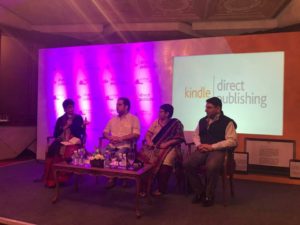Amazon KDP event in New Delhi, 30 Nov 2017
 I moderated a panel discussion on self-publishing for Amazon Kindle Direct Publishing Author Academy. The panelists included Sanjeev Jha, Director, Kindle Content, India, successful fiction writer Vineet Bajpai, and romance novelist Sundari Venkataraman on Thursday, 30 November 2017, Le Meredien, Delhi.
I moderated a panel discussion on self-publishing for Amazon Kindle Direct Publishing Author Academy. The panelists included Sanjeev Jha, Director, Kindle Content, India, successful fiction writer Vineet Bajpai, and romance novelist Sundari Venkataraman on Thursday, 30 November 2017, Le Meredien, Delhi.
It was a fabulous event consisting of an informative presentation by Sanjeev Jha after which a lively discussion ensued. The presentation was an excellent walk through about the various features KDP offers. For instance, KDP Select, the helpline support, digital tools to help upload illustrated books particularly children’s books etc. Apparently since the KDP was launched in September 2015 there are now more than 3.2 million books available on the platform. He reisterated that many readers like to browse through books digitally and if the author is readable or establishes their reputation there is the likelihood of the book translating into actual sales of print editions. Some of the most popular genres remain romance and self-help. A categorisation which is also noted in the traditional forms of publishing too. KDP was launched with the view to allow authors to access their readers with only the digital platform in between. Over time it has proven to be quite a popular way of publishing. In Dec 2016, ebooks in five Indian regional languages were launched on the Kindle. As of now it is possible to publish books on the KDP in Hindi, Tamil, Marathi, Gujarati and Malayalam but it still in the Beta version so is not being publicised too much for now. Interesting facts emerged for instance that Amazon pays royalties to its authors depending upon how many pages have been read and not necessarily by the book. For instance, Sundari Venkataraman ( who has been a regular user of KDP since Feb 2014 and now has 20+ books on the platform) mentioned that there are months when she measures her books by the number of pages read and has notched up numbers such as 15-18,000 pages. It is not very clear how many books were opened and read or whether there was a “read through” in the process or not. Vineet Bajpai made it amply clear with his lucid interventions that publishing on KDP is a convenient process for it gives access to ready data immediately yet it also requires immense discipline and dedication to ensure that the book is discovered and read. In the short span of five months since his book was launched in August 2017, he has sold more than 25,000 print copies. Both the authors agreed that they dedicate time to marketing and promotion, otherwise as another author from the audience mentioned her ten books languish on the platform.
The audience consisted of a diverse cross-section of people. There were seasoned, award-winning authors to debut authors who had unpublished manuscripts but were not sure which method to adopt — traditional or digital. There were quite a few teenagers interested in writing who were being represented by their parents. There were storytellers in various languages keen to understand how KDP will be beneficial ? Would they be able to publish stories + audio clips of their performances? There were authors who were puzzled by the distinction between KDP and KDP Select and what it meant in terms of exclusivity and support they could expect from Amazon. There were KDP authors who had had a good experience of the platform and wished to understand how to exploit it further for everyone in the hall was in agreement that Amazon, unlike other publishing firms, is responding in real time to its users ( authors/readers) and constantly improving its bouquet of offerings. There were book bloggers, journalists ( all media), ex/servicemen, doctors, strategic study analysts, translators, poets, print publishers wishing to understand the mechanisms of digital publishing etc. Some of the pertinent questions asked by the audience present were about editing a manuscripts, ROI on publishing a book using KDP, how are books discovered from the 3.2m Kindle titles available, how do authors earn royalties especially if their books are offered in the Kindle Unlimited bundle, how is plagiarism detected, what is the ideal length of a book? The conversations went on for much longer than expected and were continued over lunch.
2017 marks ten years of Kindle. When it was first launched traditional publishers were not sure how it would affect publishing. For some years thereafter a “disruption” was noticed when ebooks became exceedingly popular and many publishers made modifications to their business models. For instance by doing away with renting spaces in warehouses for stocking printed copies of their backlists and moving to the print-on-demand ( POD) model where it is possible to order one copy at a time. Another way was to penetrate newer markets using digital devices by launching apps on smartphones and not necessarily restricting themselves to specific hardware such as the Kindle. Now notably there has been a plateauing of ebook sales and print books are becoming more and more scrumptious in production. Having said that there is no doubt that Amazon with the launch of Kindle and its KDP programme with its mechanised process has democratised the publishing of a book in a manner seen first with Gutenberg. The Industrial Revolution in the nineteenth century scaled up the productivity of printing presses by improving their construction and using steam power to operate them. Now with the digital process it has made it easy for every person to publish, circumventing publishing gatekeepers and tastemakers, accessing readers worldwide, in a very short span of time — a few hours. It is this seeming collapse of time which has sped up the process of production and expectations. Of course there is the flip side of this that despite Amazon offering its KDP authors the tools create book covers, many individuals need to invest in having their manuscripts edited as that is not a service option. Also to have the book discovered the onus of promoting the book lies with the author and not with Amazon.
The response to it has been enthusiastic with many participants writing in with appreciative notes of thanks, particularly how informative the session was!
1 Dec 2017






